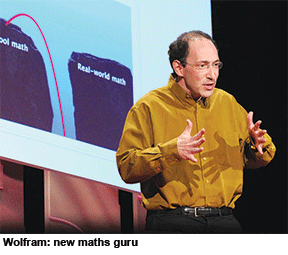 IF THE WORLD’S EDUCATION systems have a common focus, it’s to produce school-leavers who are proficient in mathematics. Governments are impressed by evidence from the World Bank and others, that better maths results raises national incomes. That, together with the soul-searching provoked by the cross-country PISA (Programme for International Student Assessment) comparisons of 15-year-olds’ mathematical attainment produced by the OECD, a club of mostly rich countries, is prompting educators in many countries to look afresh at what maths to teach, and how to teach it.
IF THE WORLD’S EDUCATION systems have a common focus, it’s to produce school-leavers who are proficient in mathematics. Governments are impressed by evidence from the World Bank and others, that better maths results raises national incomes. That, together with the soul-searching provoked by the cross-country PISA (Programme for International Student Assessment) comparisons of 15-year-olds’ mathematical attainment produced by the OECD, a club of mostly rich countries, is prompting educators in many countries to look afresh at what maths to teach, and how to teach it.
Maths education has been a battlefield before: the American “math wars” of the 1980s pitted traditionalists, who emphasised fluency in pen-and-paper calculations, against reformers led by the country’s biggest teaching lobby who put real-world problem-solving, often with the help of calculators, at the centre of the curriculum. A backlash followed as parents and academics worried that the ‘new maths’ left pupils ill-prepared for university courses in mathematics and the sciences. But as many countries have since found, training pupils to ace exams is not the same as equipping them to use their hard-won knowledge in work and life.
Today’s reformers believe new technology renders the old argument redundant. They include Conrad Wolfram, who worked on Mathematica, a program which allows users to solve equations, visualise mathematical functions and much more. He argues that computers make rote procedures such as long division, obsolete. “If it is high-level problem-solving and critical thinking we’re after, there’s not much in evidence in a lot of curriculums,” he says.
Estonia’s government has commissioned Wolfram’s consultancy in Oxfordshire to modernise maths courses for secondary-school pupils. In January, it started pilot lessons built around open-ended problems which have no single solution. One example: “What’s the best algorithm for picking a romantic date?” (Possible answer: go on more dates with a lower quality threshold to maximise the chance of success.) Another: “Am I drunk?”, which leads into quantitative analysis involving body masses, rates of alcohol absorption and other variables.
Some PISA stars are also seeking a new approach. Singapore’s government has commissioned David Hogan, an Australian maths educator, to assess its syllabus. It wants pupils to be able to explain what they know to their classmates, and to apply it in unfamiliar situations.
Andreas Schleicher, the statistician in charge of the PISA studies, agrees that many of the algorithms — rote procedures for solving familiar problems — that children have traditionally spent years mastering are now easy to “digitise, automate and outsource”. But he cautions against concluding that they are therefore no longer worth teaching. A third of pupils tested in Shanghai, which tops the PISA maths tables — and where pupils drill in mental arithmetic, start algebra young and learn formulae by heart — can apply their knowledge to novel and difficult problems, compared with 2-3 percent in America and Europe.
(Excerpted and adapted from The Economist)